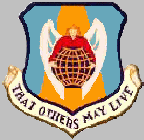
Home
FACs
More About FACs
The AO
A Shau Valley
• A Shau SF Camp
Hué
• Hué Cit Airfield
• MACV Compound
• LCU Ramp
• Hué Goose
Battle of Hué (Tet 1968)
• Trail FACs
The Missions
Visual Recon
• Sunken Sampan
Close Air Support
• CAS Munitions
• Rules of Engagement
• TACS
• Battle at Hua Cu
Interdiction
• McNamara Line
• Choke Points
Ranch Hand
Trail Dust Mission
Arc Light
SAR
Hammer 51 Rescue
Search for Jolly 23
• Msn Reports
• Search Area Map
• Search Rejoined
• Link to Past
Jungle Penetrator
Legacies
Aircraft
O-2A
Glossary
Resources
Contact
|

| |
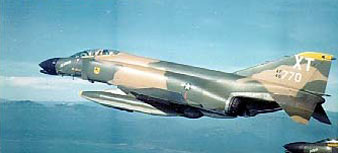
F-4C photo courtesy of the
National Museum of the U. S. Air Force
(Incident aircraft was 12th TFW 64-0767, same markings)
The Rescue of Hammer 51 A & B
January 24, 1969, A Shau Valley
In the last week of January 1969 my detachment at Hue was tasked to participate in a major bombing effort against targets in the
A Shau Valley.
This was in preparation for a U.S. ground operation into the area.
We were conducting air strikes all day and had one of our FACs over the Valley almost constantly during daylight hours.
Around mid-morning on January 24th I was en route to the Valley to relieve another FAC, Speedy 11 from Da Nang.
I was listening to him work a pair of
F-4s from Cam Ranh Bay,
Hammer 51 & 52, when I heard a call from the leader as he pulled off a bomb run:
"We've got a fire light!" * quickly followed by a
more urgent, "We've got two fire lights! We've got two fire lights!
We're bailing out. Mayday! Mayday! Hammer 51!"
* (engine fire warning light)
This was not going to be a routine day for anyone.
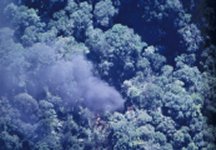 |
| The remains of Hammer 51 |
By the time I arrived over the scene, I could see the smoke rising from
the jungle to mark where the jet had impacted. There was
nothing left of the aircraft, and if it had not been for the smoke I
would not have been able to find the location.
The two survivors were on the ground (or, rather, in the trees) about
100 meters apart and maybe five kilometers north of the crash site.
They were located in the hills on the east side of the A Shau
Valley just east of the abandoned A Luoi airfield. This was
not a friendly area, as we had been tracking increasing enemy
activity during the previous weeks.
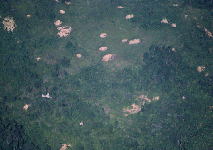
|
Speedy 11 orbits over survivors. The 'chutes are at 12 o'clock (far) and 2 o'clock (near) from
the aircraft.
(Click on image for larger view.)
|
Speedy 11 was orbiting over the survivors to make radio contact and
assure them that help was on the way. When he approached his
bingo fuel, he briefed me on the situation and then headed for home.
I established radio contact with the two survivors, Hammer 51A (front
seater) and Hammer 51B (GIB: guy in back). I also made lots of low
passes over the area to let them know that somebody was there.
I took care not to pass too close so as not
to tip off the unfriendlies as to their location. The center
of my pattern was about one klick (kilometer) north.
After about 30 minutes I was contacted by Sandy 01, the SAR task
force commander flying an A-1 Skyraider.
I talked them into my location and pointed out the survivors (their chutes were very visible against the jungle forest canopy).
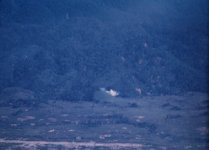
|
Sandy 01 marks target with WP rocket for accompanying fighters.
(Click on image for larger view.)
|
He acknowledged the briefing and assumed on-scene command. I
exited stage west but remained on frequency to monitor the situation and orbited over the A Luoi airfield, about three kilometers
west, to watch the show.
I saw a very professional performance. ... those Sandys were
good! The leader worked his wingman in with several sets of
fighters to "sanitize" the pickup area before bringing in the Jolly
Green chopper. He marked his targets carefully with Willie Pete
(WP or white phosphorus) rockets so that the ordnance would not be too close
to the survivors.
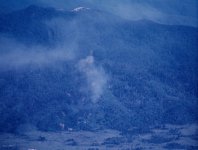
|
Smoke from CBU detonations up
the hill from the survivors.
(Click on image for larger view.)
|
As it was, the first bomb that went off up the hill brought a
high pitched radio call from one of the guys on the ground who wasn't
expecting it. I couldn't blame him.
I knew when the CBUs (cluster bomb units) were dropped that the final act was about to begin.
These were hand grenade-sized antipersonnel submunitions used to suppress Triple-A (anti-aircraft artillery).
These weapons spread shrapnel over a large area and were effective for keeping gunners' heads down.
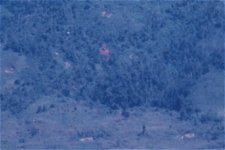
|
The Jolly Green Giant (HH-3)
hovering to pickup first survivor.
(Click on image for closer
view.) |
Care had to be taken that the survivors were hugging the ground when CBUs were used,
but at this point most of them were so glad to see the drama unfolding that they willingly complied.
Before the smoke could clear away, the
HH-3 Jolly Green Giant helicopter was moving in
for the first pickup. At the direction of Sandy 01, the
survivor popped a smoke flare which can be seen as a red cloud around
the faint image of the helicopter. I apologize for the poor
quality of the photos, but there was a lot of metal (friendly and
unfriendly) flying over the pickup site, and it was no time for a
tourist with a camera to get up close.
I was amazed at how long the choppers had to maintain hover during
the pickup. The
jungle penetrator (seat device) had to be
slowly lowered after the Jolly Green came to a hover. The
survivor needed to locate the penetrator, open the seat and strap
himself onto it. A PJ (Parajumper, a rescue specialist
crewmember) sometimes rode the penetrator down if the survivor needed
assistance. The hoist cable had to be rewound deliberately to
avoid twisting and other stress to the steel cable. It seemed
like a long time to an observer; it must have seemed like an eternity
to the guys in the chopper who were hanging it all out, motionless,
just above the trees. They had my respect.
At last two very happy survivors were safely on board, and the
helicopters pulled off and headed back to Da Nang. The Sandys
and the supporting fighter cover had some ordnance left over, and I
directed four sets of fighters into the area where the deadly gunfire
originated before I headed home. It was a long mission, 3 1/2
hours, but it had a good ending.
The next morning at first light I was back over the A Shau Valley.
The two parachutes that had been snagged high in the tree tops
were gone. Charlie had gotten himself some souvenirs.
Better two slightly used parachutes than two American pilots.
Fast forward 20 years to the spring of 1989 in Newport, Rhode Island.
I was assigned to U.S. Forces Command joint staff at Fort
McPherson in Atlanta and was attending an interagency drug
interdiction conference at the Naval War College. At lunch I
was sitting with another Air Force colonel, Dick Rybak, from the
Atlantic Command staff. We were talking about our experience
in the war. Dick said that he had flown
F-4s out of Cam Ranh Bay.
I remarked that I had been a FAC and worked with a lot of F-4s from the
12th Tactical Fighter Wing
in the A Shau Valley.
He gave me a strange look and very quietly said, "I was shot down over the A Shau Valley."
After comparing notes, I told him that I thought I had been there and might have some pictures of the rescue.
After I got home, I dug through my old footlocker and came up with
the slides and my logbook. There for January 24, 1969, was the
entry:
SAR for Hammer 51A & B in A Shau; both rescued.
4 airstrikes on a/w position.
[Note: a/w: automatic weapon]
I now had a name and a face to put against a log entry. Dick told me that the front seater (Hammer 51A) was then-Major
Bob Russ. In 1983-5, Lieutenant GENERAL Russ had been my boss in the Pentagon, but we had never made this connection.
At the time of my meeting with Dick Rybak, General Russ was the commander of the U.S. Air Force Tactical Air Command at Langley AFB,
Virginia. I was working for General Colin Powell as his Deputy Chief of Staff at Forces Command and, by coincidence,
General Powell was preparing to attend a conference with General Russ on joint air rescue doctrine.
I told General Powell about the rescue of Hammer 51 and showed him the slides I had taken.
He took them with him to the conference.
At an appropriate point he had the slides projected on the screen and told the story of how a future four-star general was plucked from the jaws of fate.
General Powell told me later that General Russ got very quiet when he saw the pictures and relived what must have been a significant emotional event in his life.
SAR
Return to Top
Search for Jolly Green 23
|
|
|







